All spoilers regarding the Skywalker Saga and The Clone Wars are unmarked. Examples relating to Disney's films and EU can be spoiler-tagged if deemed necessary.
Tropes specifically applying to creatures based on their appearances in Star Wars Legends can be found here.
To return to the Character page for Star Wars, go here.
- Fed to the Beast: A popular way of dealing with enemies among the franchise's villains.
- In Attack of the Clones, the Geonosians try to get rid of Obi-Wan, Anakin, and Padmé by feeding them to an Acklay, a Reek and a Nexu in a gladiatorial arena.
- In Solo, Beckett tries to do this to Han. Said "beast" turns out to be Chewbacca, and they break out together. (Yes, this is how Han and Chewie met.)
- In Return of the Jedi, Jabba tries to feed Luke to his Rancor, Pateesa. When that fails, he tries again with the Sarlacc.
- Non-Malicious Monster: While many of the creatures are very lethal and highly aggressive, none of them can truly be called evil. At the end of the day, they are simply non-sentient or semi-sentient animals, just very hungry or territorial ones whose size and natural weapons make them especially dangerous.
- Rent-a-Zilla: Quite a few beasties are large enough not to be out of place in a Kaiju movie, with the Sando Aqua Monster, the Exogorth, the Sarlaac, and the Krayt dragon being four of the most notable examples.
- Running Gag:
- In five out of the original six films that George Lucas was directly involved with creating, the protagonists are attacked by some sort of nasty and large beast. The only one to avert it is Revenge of the Sith. However the original script included a scene in which Obi-Wan would've had to fight a Nos Monster, after he fell into the underground lake on Utapau, following the execution of Order 66. This is continued in The Force Awakens with the rathtars.
- The Prequel Trilogy introduces the largest known aquatic creature, the Sando Aqua Monster. The Clone Wars introduces the largest known land creature, the Zillo Beast. Solo, an anthology film, introduces the largest currently-known creature in the whole galaxy, the Summa-verminoth, and the Original Trilogy introduces the then-largest space-dwelling creature and creature in general, the Exogorth.
Multiple Worlds

Stocky, bipedal, and long-tailed reptilian herbivores, Blurrgs could be found on many worlds across the galaxy and were mostly used as mounts and beasts of burden, but were also useful for agricultural labor and war.
- Canon Immigrant: They originally came from the now-Legends film Ewoks: The Battle for Endor and made their canonical debut as a result of appearing in The Clone Wars episode "Liberty on Ryloth".
- Conceive and Kill: According to Kuiil, female blurrgs kill and eat the males after mating with them.
- Dumb Muscle: Blurrgs aren't particularly smart, but they sure are strong.
- Hair-Trigger Temper: These beasties are quite ill-mannered and can get agitated easily.
- Horse of a Different Color: Twi'leks have tamed the blurrgs and use them as war steeds. So does the Ugnaught Kuiil, but for his farm/travel needs instead.
- Mix-and-Match Critters: A theropod-like reptile with a huge, piranha-esque head and legs like those of an elephant.
- Prehistoric Animal Analogue: They look like short, chubby and stunted theropods with big heads.
- Schrödinger's Canon: In the Legends Ewoks films, they were originally native to Endor and dozens of them were acquired by the Twi'leks for their use during the Clone Wars. Legends sources also expand on their behavior and feeding habits.

Long-tailed birds resembling owls, convoree can be found living on many worlds throughout the Galaxy, including Atollon, Malachor, and the Trandoshan moon of Wasskah. They seem to have some unexplained connection to the Force.
For tropes specifically referring to Morai, see the Star Wars – Other Force-Users and Beings page.
- All There in the Manual: Absolutely Everything You Need to Know, Updated and Expanded explains that the convoree and the birds on Wasskah and Kiros are variants of the same species. The ones from Wasskah are called Wasskah convoree, the ones from Kiros are called Kiros birds, and the ones on Atollon and Malachor don't seem to have a specific variant name.
- Ambiguous Situation:
 Word of God is that they do have something to do with Ahsoka and the Force, and Ahsoka's fate is relevant to the events of Mortis. Curiously, one of the convoree we've seen has the same color palette as the Daughter. After "Twilight of the Apprentice", another convor the show has briefly focused on has natural brown colors for its palette instead, though it's unknown if this brown convor is actually relevant or just a regular convor. As of the midseason trailer, which shows Ezra finding a painting of the Daughter with the convor on her shoulder, it seems to be confirmed that that convor is connected to her.
Word of God is that they do have something to do with Ahsoka and the Force, and Ahsoka's fate is relevant to the events of Mortis. Curiously, one of the convoree we've seen has the same color palette as the Daughter. After "Twilight of the Apprentice", another convor the show has briefly focused on has natural brown colors for its palette instead, though it's unknown if this brown convor is actually relevant or just a regular convor. As of the midseason trailer, which shows Ezra finding a painting of the Daughter with the convor on her shoulder, it seems to be confirmed that that convor is connected to her. - Amplified Animal Aptitude: Kiros birds (or at least Queen Miraj's) are said by All There in the Manual to be highly intelligent and can understand conversations.
- Mix-and-Match Critters: Otherwise normal birds with monkey tails.
- Mysterious Animal Senses: They seem to have some kind of Force sensitivity. They also tend to follow Ahsoka, especially when she is in trouble. According to All There in the Manual, they're believed to be omens of impending events of importance — especially events concerning the Force.
- Mysterious Watcher: On several occasions, one of their number, Morai, has observed events relating to Ahsoka and the Dark Side. On one occasion, a group of them gather to watch Sabine being trained by Ezra and Kanan to wield the Darksaber, in a situation where she wasn't in any danger. Perhaps Foreshadowing how she will eventually become Ahsoka's apprentice and eventually a Force-wielding Jedi.
- Ominous Owl: While not malicious, they tend to show up when Light-sided characters (Ahsoka in particular) are threatened by the Dark Side. All There in the Manual reveals that its presence means that something important (probably Force-related) is going to happen.
- Palette Swap: Each of the variants have different color schemes. The Wasskah convoree are yellow, the Atollon/Malachor convoree are brown (an exception being one that is colored like the Daughter of Mortis), and the Kiros birds are purple and blue-green.
- Prehensile Tail: Their monkey-like tails are prehensile, and at one point a small flock is shown using theirs together to lift a predator into the air before letting it fall.
- Ridiculously Cute Critter: Their The Clone Wars design has big round eyes, on big round faces, on small round bodies with short wings and legs. Their behavior in the Trandosha arc that introduced them took it even further, with the way they rubbed against one another, and how they dispatched of a group hunting them.

A species of large, quadrupedal and squat herbivores, happabores had broad, porcine noses and thick armored skin which protected them from harsh climates. They were rather useful as beasts of burden and were widespread among many planets of the galaxy thanks to a long-forgotten colonization effort.
- Beware the Nice Ones: Happabores are very docile, but they will not hesitate to use their massive jaws and big tusks to defend themselves should the need arise.
- Full-Boar Action: It has some warthog influences on its design, and, while it is mostly calm, it will nonetheless fight with everything it has against its attackers.
- Gag Nose: Seriously, *look* at that snout.
- Horse of a Different Color: They could be used either as beasts of burden or mounts, and were quite durable.
- Mix-and-Match Critters: Overall, they resemble short, squat mixtures between rhinoceri, with their armor, elephants, with their legs, and warthogs, with their porcine noses and tusks.
- Nice Guy: They were very friendly, obedient animals, which made them very easy to domesticate.
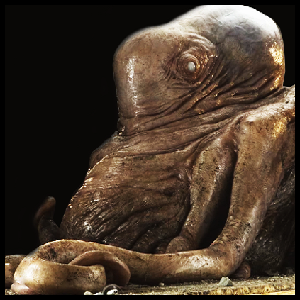
Also known as Bors, Mairans were large, tentacled mollusks with the ability to read minds which were usually used as a form of torture.
- Adaptational Nonsapience: In Legends, Mairans were a sapient species, with one of the most famous members of the species even being a Jedi. In Canon, they seem to be merely semi-sapient despite their psychic abilities, and are often seen as little more than living torture devices.
- All There in the Manual: The Doctor Aphra comics, namely the second part of The Catastrophe Con, first identify the species by their true name of Mairan. In addition, the 2018 reference book Star Wars: Alien Archive-Species Guide reveals they are native to Maires.
- Bizarre Alien Biology: It is currently unexplained how they are able to read the minds of sentients and devour their memories. Granted, their true diet is still unknown.
- Canon Immigrant: Mairans actually came
 from Legends, and originally made their debut in the sixth book of the Young Jedi Knights series, Lightsabers.
from Legends, and originally made their debut in the sixth book of the Young Jedi Knights series, Lightsabers. - Combat Tentacles: Their long, powerful tentacles allow them to restrain their prey and render them helpless.
- Laser-Guided Amnesia: Bors can completely consume the memories of anyone unfortunate enough to encounter them, as poor Bodhi found out. Harra the hutt also claims a Gand bounty hunter drunk on jet juice once took a waif from Genhu to her own Bor, which wiped the girl's memories away.
- Lovecraft Lite: Huge, tentacled Starfish Aliens that can render you insane with their powers? Oh yeah. Thankfully, these guys are simply fauna, and are most definitely not horrifying deities. Plus, their effects do not seem to last very long, as Bodhi managed to come back to his senses upon hearing the word "pilot".
- Mind Probe: Their ability to read and eat away memories made them successful as torture methods.
- Mind Rape: Given how poor Bodhi briefly ended up as a nervous, stuttering wreck after Saw had Bor Gullet probe the former Imperial's mind, we can only assume the way they read minds is most definitely not a pleasant experience.
- Schrödinger's Canon: In Lightsabers, the sixth book of the Young Jedi Knights series, Mairans are shown to be largely aquatic and could only stay on land for long periods of time if showered periodically by tanks they wore on their backs (this does not seem to have been brought to the new canon, however). Despite their bestial appeareance, they were actually sentient Starfish Aliens that spoke in a musical language played on a shell flute but could speak Basic. In fact, the most famous member of the species, Gar Anstak, was a Jedi Master, albeit Force-sensitive Mairans were often shunned by their community. They also had a rivalry with the Hapans of Vergill.
- Uncertain Doom: Bor Gullet most likely met its end when the Death Star fired at Jedha on low power, considering it was still in the Catacombs of Cadera at that point.
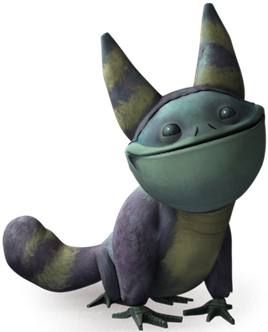
Small, cat-like animals found throughout the galaxy, often kept as pets or as pest control. The loth-cat is a specific breed of tooka native to the planet Lothal. Tookas are often kept aboard starships as pest/vermin control, such as pikobis.
- Breakout Character: Their popularity in the fandom has come with a couple of points in Rebels where they are relevant to the plot. Namely:
- In "Call to Action", Ezra uses the Force to make a loth-cat attack an Imperial probe droid in an attempt to destroy it in a way that won't make the Empire suspicious so he, Kanan and Sabine can sneak away unnoticed. It nearly works.
- In "Legacy", a white loth-cat leads Ezra into discovering what happened to his parents, as well as meeting Governor Azadi. It returns in Season 4 as a part of the Lothal nursery rhyme prophecy.
- In "Through Imperial Eyes", Thrawn is able to deduce that Kallus has had a Heel–Face Turn and is The Mole, thanks to Sabine's loth-cat art.
- Call a Smeerp a "Rabbit": They are referred to as cats, but their faces more resemble some kind of frog-primate hybrid.
- The Cameo:
- Briefly appears in "An Inside Man" during the walker scene, after having been unseen for about half a season due to the story taking place mostly off of Lothal.
- A brown one (similar to a lothcat, if not an actual lothcat) scares the Child at the cantina on Sorgan in The Mandalorian Chapter 4.
- Cats Are Mean: They're not necessarily evil, but loth-cats at least have terrible tempers, and are very aggressive.
- Chekhov's Gunman: After being left behind with no comment in "A Princess on Lothal", the white lothcat returns in Season 4. It turns out that it's not Azadi's pet, but rather a manifestation of the Force, along with the white lothwolf.
- Cute Kitten: Unless you agitate them, which then becomes
 Ugly Cute until they rip your face off.
Ugly Cute until they rip your face off. - Evil-Detecting Dog: One living with Sabine senses a HK droid and hisses at it, alerting Sabine to an attack she would otherwise have never seen coming.
- Killer Rabbit: They're easily temperamental, and apparently, they've attacked a farm once.
- Mix-and-Match Critters: Their feet resemble those of birds.
- More Teeth than the Osmond Family: Kind of. It's not as many as a shark's or anything like that, but it has a big mouth that lets you see its set of teeth if you somehow tick one off. According to All There in the Manual, they have 28 teeth.
- Noodle Incident: A Freeze-Frame Bonus/Bilingual Bonus in the news broadcast for "Empire Day" reports that a farm got attacked by lothcats.
- Shout-Out:
- The brown lothcats resemble the fox squirrels from Castle in the Sky. Given the Star Wars cartoons have made Shout Outs to anime including Studio Ghibli works before, this seems deliberate.
- Whenever Ezra sees the white lothcat, he believes that he should follow it. Follow the white lothcat, anyone? Also, the first time he saw it, it became a Down the Rabbit Hole of sorts, since Ezra began to fall to the dark side after discovering what the white lothcat had led him to.
- Tuckerization: "Tooka" is derived from "Tuuk", the name of Dave Filoni's deceased cat.
Core

A fleet-footed, loud-barking, vicious hound species from Corellia. They are used for attack and hunting, by the White Worm gang most notably. They do not make good pets.
- Fantastic Fauna Counterpart: Territorial, nominally domesticated alien quadrupeds who play the same role as guard and attack dogs.
- More Teeth than the Osmond Family: They have a number of teeth and all are pretty sharp.
- Right-Hand Attack Dog: The Grindalid and White Worm gang enforcer Moloch uses two of them to hunt down Han Solo and Qi'ra in the streets and spaceport of Coronet City.
- Shout-Out: According to
 Word of God, the Corellian hounds are a homage to the Death Dogs from Willow.
Word of God, the Corellian hounds are a homage to the Death Dogs from Willow. - They Have the Scent!: Moloch uses them to track down Han and Qi'ra at the spaceport.
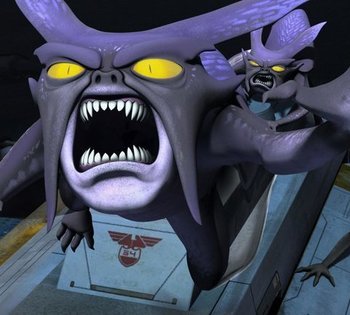
Nocturnal, carnivorous predators native to the planet Anaxes, a nest of which survived the planet's destruction to live on in an abandoned Republic base.
- The Cameo: Even though the creatures were originally made for Rebels and didn't feature in the original reel, a few fyrnocks can be seen in the background of Anaxes' forest in the finished version of "The Bad Batch".
- Super-Persistent Predator: In "Out of Darkness", they go through waves of blaster fire and explosions to try and get at Hera and Sabine. Probably justified in that they've had very little to eat since their planet's destruction — the fyrnocks that appear in "The Bad Batch" act like more normal wildlife and give sentients a wide berth.
- Weakened by the Light: They can't stand direct sunlight, although they don't have the same problem with artificial light.
Inner Rim

Onderon's apex predator.
- Flower Mouth: They are shown to have splitting mouths in their visual appearances, with two pairs of lateral jaws between their upper and lower sets.
- Our Hydras Are Different: They are giant, carnivorous three-headed lizards that can spit out toxic gas, effectively making them space hydras.
- Poisonous Person: They ca spit noxious gases.
- Vertebrate with Extra Limbs: They've got six legs.
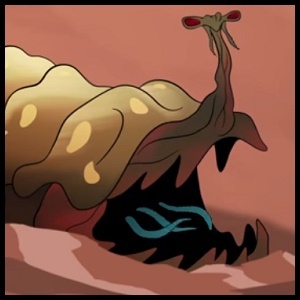
Also known as "Arconan night terrors" and "sandborers". They are a species of nocturnal sand-boring worms native to Jakku. Mature specimens top 20 meters in length, although some are reputed to be much larger.
- Big Little Man: Only the creature's hammer-shaped head can be seen in The Force Awakens, observing BB-8 as he flees the First Order's attack. The whole creature appears in Forces of Destiny.
- Bizarre Alien Biology: The worms have mutliple tentacle-shaped tongues and a nasal horn-like limb that ends with a hammer-shaped head. Said head includes the Nightwatcher's eyes, it is used like a periscope when the beast is hiding under the sand.
- Call-Back: Their hammer-shaped heads give them a superficial resemblance to the sentient Arcona species
 , which earned them the alternate name of "Arconan night terrors". Indeed, the one we see in The Force Awakens (which may or may not be the same individual that Rey and BB-8 encounter later on) raises its head and turns it around while seeing BB-8 roll by in the same way as Hem Dazon
, which earned them the alternate name of "Arconan night terrors". Indeed, the one we see in The Force Awakens (which may or may not be the same individual that Rey and BB-8 encounter later on) raises its head and turns it around while seeing BB-8 roll by in the same way as Hem Dazon , an Arcona patron of Chalmun's Cantina who is the first non-Jawa or non-Tusken alien to appear in A New Hope.
, an Arcona patron of Chalmun's Cantina who is the first non-Jawa or non-Tusken alien to appear in A New Hope. - Extreme Omnivore: They can eat anything, since their mouthparts can grind metal into scrap, and their stomachs generate acid to melt down anything they cannot digest.
- Fast Tunnelling: They move very fast under the sand.
- Hungry Menace: One of them tries to eat BB-8 in Forces of Destiny (after presumably following him since the First Order attack night in The Force Awakens), purely out of hunger. After saving BB-8 from the creature, Rey feeds the Nightwatcher with metal scrap.
- Sand Worm: They live in the sands of Jakku. They remain under the sands motionless, but at the slightest vibration from something moving on the surface, they spring up and snap onto their preys.
- Shout-Out:
Expansion Region
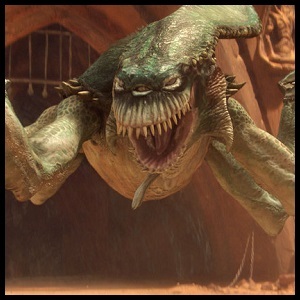
A six-legged creature similar to a crustacean, the acklay is a very dangerous predator on its homeworld.
- Big Creepy-Crawlies: A ferocious crab/mantis hybrid with the jaws of a Velociraptor.
- Crippling Overspecialization: According to
 Word of God, the reason it wasn't able to just stab its claw into Obi-Wan is this trope; the Acklay comes from a tropical planet without a lot of light, so its eyes are best adjusted and suited to low light levels. On the bright, sunny desert planet Geonosis, the Acklay's eyesight is very poorly suited and so it can't get a particularly good look at Obi-Wan.
Word of God, the reason it wasn't able to just stab its claw into Obi-Wan is this trope; the Acklay comes from a tropical planet without a lot of light, so its eyes are best adjusted and suited to low light levels. On the bright, sunny desert planet Geonosis, the Acklay's eyesight is very poorly suited and so it can't get a particularly good look at Obi-Wan. - Extra Eyes: It has a total of three.
- Hell Is That Noise: Acklays have a very distinct high-pitched, bone-chilling shriek.
- Mix-and-Match Critters: It looks like a cross between a crab, a praying mantis and a dinosaur.
- No-Sell: Obi-Wan tries to toss a spear into its hide. Its response is to pull the spear out of its own body and snap it in half with its teeth.
- Sea Monster: They are primarily aquatic creatures and in nature normally inhabit their homeworld's oceans, but occasionally emerge onto land to hunt their prey.
Mid Rim
Frog-like creatures with piranha-like teeth. They are considered a tasty delicacy by many alien species and are used as bait for the aquatic creatures in the oceans of Castilon.
- Ascended Extra: They were background creature in The Phantom Menace and were promoted to Series Mascot for Resistance.
- Culture Clash: Kaz is surprised to learn that gorgs on the Colossus are usually bought as food and Eaten Alive rather than kept as pets.
- Depending on the Artist: In The Phantom Menace, they look like large frogs with a Kermit-esque head, while in the more cartoon-stylized Resistance, their heads make up most of their bodies. Could be justified as gorgs on Castilon being a different variant than the ones seen on Tatooine.
- Eaten Alive: How alien species eat them. It's implied they're either swallowed whole or you're supposed to bite them in large chunks, given how fast Neeku downs one in one Resistance episode.
- Mascot: After accidentally wrecking Grool's gorg stand in the first episode, Kaz makes up to him by agreeing to paint a gorg decal on the Fireball to advertise his business.
- Mix-and-Match Critters: Looks like a frog, has More Teeth than the Osmond Family like a piranha, and has fins like any other fish.
- More Teeth than the Osmond Family: And as Kaz learns the hard way, they bite.
- Pint-Sized Powerhouse: Small enough to be easily carried in someone's hand, but capable of causing a proper ruckus when they get loose, something Kaz and Torra take advantage of once as a distraction.
- Series Mascot: Of Resistance.
A colossal cephalopod native to the waters of Castilon.
- Extra Eyes: Like most creatures native to Castilon, rokkna have a total of four eyes.
- Kraken and Leviathan: Adults such as Bibo's mother are big enough to pose a direct threat to the Colossus when enraged.
- Mama Bear: Bibo's mother goes on a rampage against the Colossus when her son goes missing, but relents when Neeku hands Bibo back to her.
- Monster Is a Mommy: In "Bibo", Team Fireball realizes that an adult is attacking the Colossus because she's trying to rescue her son. The drastic size difference between mother and offspring makes Neeku and Tam initially think Bibo's mother wants to eat him until they get a good look at her eyes.
- Ridiculously Cute Critter: Played with. Neeku finds young rokkna like Bibo adorable but his human friends find the stench unbearable or just find Bibo to be an annoying pest that gets in the way of their work (and eats metal, including droids like Bucket). Outside of that, Bibo looks like a more alien and slightly larger baby octopus and lacks some of the more terrifying features of his mother.
Kashyyyk

Brightly glowing beetles found on Kashyyyk.
- Canon Immigrant: They first appeared in the Legends Marvel Star Wars comic "Wookiee World".
- Taking You with Me: They explode when killed.
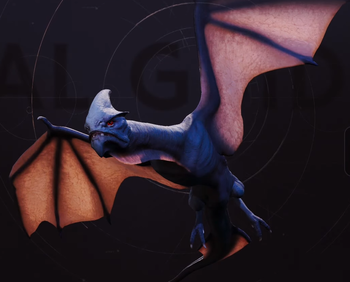
Flying reptiles native to Kashyyyk.
- Adaptational Badass: In Knights of the Old Republic, Mykals were rather unremarkable enemies and could go down in just a few hits at the earliest point in the game they could be encountered. In Jedi: Fallen Order (being an action game instead of an RPG with a d20 combat system), Mykals were reimagined as frail, but speedy creatures that rely on hit-and-run tactics.
- Canon Immigrant: These creatures previously appeared as minor enemies on Kashyyyk in Knights of the Old Republic, which was their only appearance in Legends.
- Fragile Speedster: They're quick and very difficult to hit, but can't take a lot of punishment.

A massive bird that serves as the guardian of the Origin Tree on Kashyyyk.
- Androcles' Lion: It attacks the Ninth Sister's TIE and is wounded in the attempt. Cal later finds it and removes the jagged fragment impaling its wing before healing it with a stim, and it aids him by serving as a point of fast travel from then on.
- Disney Death: After Cal learns there is another Astrium on Dathomir, the Ninth Sister's TIE shoots the Shyyyo Bird in the back and it falls from the tree while Cal takes on the Ninth Sister herself. After the battle, the bird returns having survived its injuries.
- Gentle Giant: It's not a hostile creature, though it is very willing to bodyslam a TIE attacking Cal, and later befriends him after he heals it.
- Giant Flyer: A giant bird with feathers that resemble dragonfly wings.
- Last of His Kind: It's speculated to be the last Shyyyo Bird left in existence.
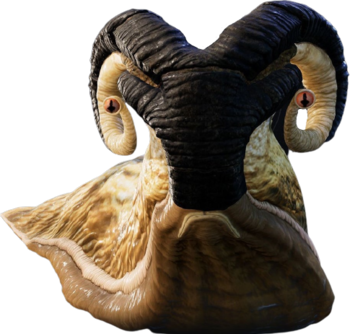
Giant slug-like creatures native to Kashyyyk.
- Acid Attack: They spit acidic slime at prey and predators alike.
- Mighty Glacier: They're not very quick, except in close quarters.
- My Nayme Is: Slug like creatures called "slyyygs".
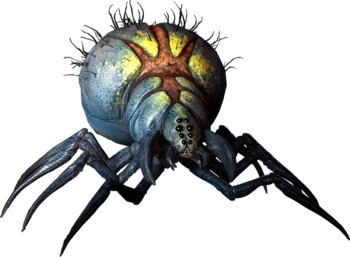
Giant arachnids native to Kashyyyk, including the more powerful Albino Wyyyschokk that makes its home near an Imperial Refinery.
- Canon Immigrant: They first appeared in Han Solo and the Lost Legacy.
- Giant Spider: Uncomfortably so, looking basically like normal spiders with exaggerated fangs and being capable of spitting webs at enemies to trap them.
- Jump Scare: Step on their webs and one will leap out to pounce on you.
- One-Hit Kill: Cal can parry their lunges and then leap on top of them while they're stunned and kill them with a single stab.
- Projectile Webbing: They can launch three balls of webbing and bind enemies on the spot.
- Spread Shot: They fire their webbing in three balls in front of them.
- Unique Enemy: The Albino Wyyyschokk is the optional boss fought on Kashyyyk
Naboo
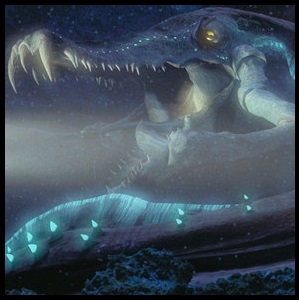
One of the large predators dwelling in the oceans of Naboo.
- Bioluminescence Is Cool: Has bioluminescent patches down its sides.
- Cold-Blooded Whatever: Its body is eel-like, but its head is reptilian, resembling a crocodile. It also has arthropod-like claws thrown in for good measure.
- Mama Bear: Mother Colo Claw Fishes are extremely protective of their young.
- Mix-and-Match Critters: It has a head that resembles a crocodile, a moray eel-like body and clawed arms similar to the legs of a crab.
- Monstrous Mandibles: In the form of what are essentially full-blown, articulated crablike limbs on the sides of its mouth, emphasizing its alien and dangerous nature.
- Never Smile at a Crocodile: Its head looks similar to depictions of ancient sea-dwelling crocodiles, and it is a nasty predator.
- Sea Monster: It resembles a giant eel with a vaguely crocodilian head and clawed mandibles.
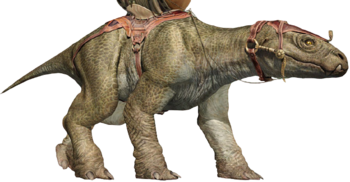
Gigantic, slow-moving, and quadrupedal amphibians found on Naboo, Fambaas were domesticated by the Gungans in their homeworld and had also found their way to Onderon.
- Beast of Battle: They're used as beasts of burden and steeds of war by the Gungans, who equip them with booma cannons and shield generators for their battle against the Separatist droid army.
- Cryptic Background Reference: How they and the Falumpasets got to Onderon remains unexplored. Biologists believed they were originally brought to the planet by Naboo merchants, but there's not enough fossil evidence to support this hypothesis.
- Mix-and-Match Critters: A large dinosaur/lizard-looking being with elephantine legs that is also an amphibian.
- Schrödinger's Canon: In Legends, Fambaas are stated to be herbivores and gregarious beings which move on massive herds.
- Stock Sound Effects: Their calls are reused from the Bantha.
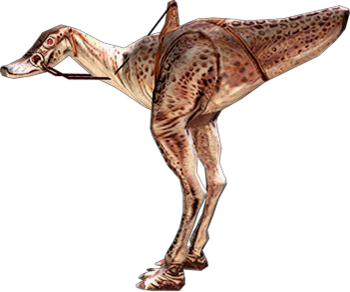
Amphibious bipedal reptavians native to Naboo. Gungans use them as mounts.
- Aquatic Hadrosaurs: Kaadus resemble slender, armless hadrosaurs, live in swamplands, and are established in supplementary materials to be agile swimmers and divers.
- Armless Biped: They have no forelimbs of any sort.
- Explosive Breeder: Female kaadus lay between 100 and 250 eggs at a time.
- Horse of a Different Color: Gungans frequently use them as mounts.
- Prehistoric Animal Analogue: Hadrosaurs were a primary influence on their design and they're practically a Call-Forward to what Deinocheirus would be found to look like, minus the hump and arms.
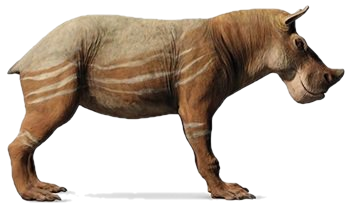
Quadrupedal animals from Naboo with a horn on their nose, Motts were herbivores that fed mainly on swamp vegetation.
- Explosive Breeder: Motts have a high reproduction rate and can give birth to up to 15 babies per litter.
- Horn Attack: Fitting for an animal based on a rhinoceros.
- Mix-and-Match Critters: Has the overall shape of a rhinoceros, with legs like those of primitive ungulates such as Eohippus
 and the snout of a hippopotamus.
and the snout of a hippopotamus. - Rhino Rampage: Befitting their design, Motts may be herbivores, but they put their horns to good use and rely on them for defense, mating disputes and searching for food in the mud. In Obi-Wan and Anakin, issue 2, it is revealed Obi-Wan once asked Anakin to try and tame an angry Mott with the Force.
- Schrödinger's Canon: According to Legends, Motts are also semi-aquatic in nature and are gregarious, living in groups of at least fifteen individuals.

A small flightless bird native to the swamps of Naboo, also known as swamp turkeys, these creatures are infamously stupid but are also valued as cheaply and easily raised sources of meat and eggs. Due to this, they have been widely spread across the galaxy and have established feral populations on Tatooine, Coruscant, and Saleucami.
- Armless Biped: They are bird-like animals with no front limbs.
- Bizarre Alien Biology: Nunas are capable of inflating their bodies like pufferfish when angered or intimidated.
- Butt-Monkey: Whenever these guys get screen time, something bad usually happens to them. In The Phantom Menace, Jabba the Hutt flicks one to its death off a balcony during the Boonta Eve Podrace for no reason. In Attack of the Clones, one of the monitors in the Outlander Club portrays a sport that involves droids throwing nunas as balls (appropriately called nuna-ball). In The Clone Wars, they are confirmed to be the Star Wars equivalent of chickens or turkeys, as they are sometimes portrayed as prepared meals.
- Fantastic Fauna Counterpart: Reptilian hides and barbels aside, they're essentially alien chickens.
- Fantastic Livestock: They're alien animals raised for their meat and eggs in a manner very similar to chickens.
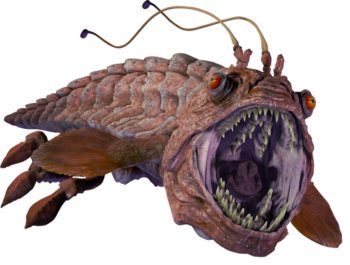
A frightful sea monster that lives in Naboo's oceans.
- Chameleon Camouflage: The first time we "see" it, it's camouflaged as a rock and Obi-Wan manages to pilot the sub right past it without seeing it.
- Mix-and-Match Critters: Looks like a mix of a crustacean and a deep sea fish, along with the tongue and eyes of a chameleon.
- Overly-Long Tongue: Its tongue is similar to that of a frog or a chameleon.
- Sea Monster: One of the more well-known Star Wars examples. These ferocious, chimeric mixes of fish and crustacean are well over the size of a submarine, and the chance of encountering one of the beasts is one of the biggest dangers in crossing Naboo's subterranean oceans.

Gigantic sea mammals living in the deep subterranean oceans of Naboo, Sandos firmly dominate the food chain of their abyssal home.
- Always a Bigger Fish: The Trope Namer "fish" (though it's more like a whale). As Qui-Gon Jinn, Obi-Wan Kenobi and Jar Jar Binks are trying to get from Otoh Gunga to the surface naboo capital city of Theed with a Gungan submarine, they're first attacked by an Opee Sea Killer, then by a Colo Claw Fish, both of which are devoured by a gargantuan Sando Aqua Monster.
- Big Eater: To maintain their huge bodies, Sandos need to eat constantly, devouring whole schools of fish and hunting other large sea monsters.
- Endangered Species: Sando Aqua Monsters can live for at least 932 years, but according to ZED-6-7, they also have glacially slow reproductive cycles, resulting in the species having a very small population. When Darth Vader killed just one specimen some time after the Battle of Hoth (and having been the first recorded person to ever do so), it decreased the species' chances of survival by 83 percent.
- Giant Equals Invincible: Plain blasters are used against one in "Monster Misunderstanding", and they don't seem to do any damage to the creature.
- Kraken and Leviathan: These things are huge, nearly seven times the length of a blue whale. The one in Phantom Menace dwarfed the other monsters seen — the Opee and Colo that already dwarfed the heroes' submarine by a fair margin — which fit comfortably in this beast's mouth, and it was able to tear off an Opee's head with one hand.
- Long-Lived: Sando Aqua monsters can live for over nine-hundred years. Unfortunately, combined with their glacially slow life cycles, this means the species doesn't get to reproduce very often, resulting in a very small population.
- Mama Bear: They're very protective of their offspring, as shown in Forces of Destiny.
- Mighty Roar: A very deep and guttural roar which only makes 'em more frightening.
- Mix-and-Match Critters: It's like a mix between a whale and a big cat, with fish-like gills and a tail.
- Monster Is a Mommy: In their appearance in Forces of Destiny one of them attacked a cargoport on the shores near Theed, because poachers had taken its calf and were hiding out in there with it.
- Rent-a-Zilla: Adults can be 200 meters long.
- Sea Monster: These things are far and away the biggest, most dangerous and most feared out of all the giant predators of Naboo's buried oceans.
- Slasher Smile: Seems to have a permanent one, due to how its face is designed.
Outer Rim

A large cephalopod with a shell, the slaver Darts D'Nar owned one as a pet that he released on Anakin and Ahsoka.
- Combat Tentacles: It attacks Anakin and Ahsoka with its tentacles.
- Disney Villain Death: It falls off the ship while fighting Anakin.
- Fed to the Beast: D'Nar attempts to feed Anakin and Ahsoka to it.
- Tentacled Terror: It has traits of squids and crabs, and shows hostility.
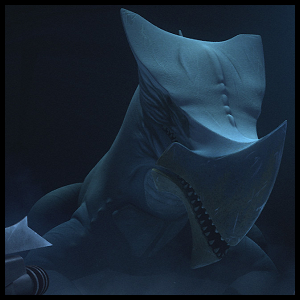
A large, carnivorous lizard native to Bahryn, an icy moon of Geonosis.
- Fluffy the Terrible: For the French dub only. The creature's name pronounced like "bons amis" in French, which means "good friends".
- Immune to Bullets: Blaster fire only annoys them. The one that is killed was shot in the mouth.
- Significant Anagram: The design of its horn and beak was inspired by that of a truck-mounted snowplow, while its name derives from "Zamboni", a brand of machines used to clean and smooth the surface of ice rinks.
A large arachnoid predator from Gand. As a rite of passage, young Gand findsmen would have to claim a T'karra flower from their nests or die trying.
- Adaptational Mundanity: In Legends, they were a species that lived on a planet in otherspace, having moved from realspace. In Canon, as Hyperspace doesn't work the way it did in Legends (where it was sometimes treated as Another Dimension) and otherspace has yet to be reintroduced because of it, the Charon seem to be naturally found on Gand.
- Adaptational Nonsapience: In Legends, they were fully sapient, albeit running on a sense of Blue-and-Orange Morality. In Canon, they simply appear to be a very dangerous animal from Gand.
- Canon Immigrant: They were originally from the Otherspace role-playing adventure book.
- Extremophile Lifeforms: They live on Gand, a planet with an ammonia-based atmosphere that others would find toxic.
- Spider People: They look like giant spider-centaurs. However, unlike their Legends counterparts, they don't seem to be sapient.
- Spiders Are Scary: While not for the same reasons as their Legends, Charon are a dreaded predator on Gand that findsmen-in-training have to steal a flower from as a Rite of Passage (and many die in the process).

Flying reptavians that act as steeds for desert travelers among the giant sinkholes of Utapau. They are also found flying among the rocky spires of Shantipole.
- Giant Flyer: A large, vaguely pterosaur-like creature.
- Horse of a Different Color: Draconic pseudo-pterosaurs used as flying mounts on a world of giant sinkholes.
- Meaningful Name: Why yes, the Dactillion looks like a Pterodactylus indeed.
- Mix-and-Match Critters: They look like a cross between dragons, lizards and pterosaurs.
- Vertebrate with Extra Limbs: Four legs, two giant wings.
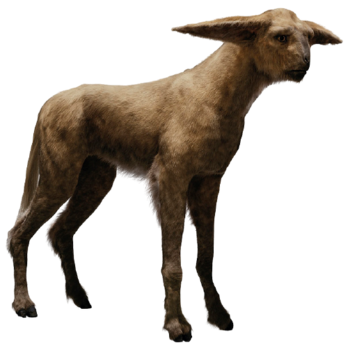
A quadrupedal species found on Cantonica. They are used like racing horses in the casino city of Canto Bight.
- Animal Stampede: Invoked. Finn and Rose free the captive fathiers in Canto Bight, and they wreck the casinos and the streets in their escape.
- Bad People Abuse Animals: Rose points out that the rich residents of Canto Bight are terrible people, and backs it up by showing Finn how they abuse the fathiers (large, four-legged mammals) on the island. Sure enough, one of the fathiers is seen with wounds on its neck before it is freed.
- Horse of a Different Color: They're long-eared quadrupedal mammals that could be tamed and used for riding. Fittingly enough, the rich people of Canto Bight have bets revolving around fathier-racing.
- Mega Neko: They resemble giant cats.

Powerful and ferocious predators from the world of Vanqor, Gundarks had quite a fearsome reputation across the galaxy.
- Bizarre Alien Locomotion: Their legs are nothing more than a pair of sharp claws, and they instead mostly move using their muscular forearms.
- Canon Immigrant: While they were already canon due to being mentioned in the films and appearing in The Clone Wars, their physical appearance is based on Legends depictions.
- The Dreaded: They're considered some of the most intimidating and violent creatures in the galaxy, and they certainly back it up with their behavior. Even Obi-Wan and Anakin, two seasoned Jedi Knights, seem suitably terrified when they encounter one of these things.
- Fluffy the Terrible: In Rebels Magazine a female Gundark owned by the Sneevel crime lord Skraik is named "Gigi".
- Hair-Trigger Temper: They can fly into a rage at the smallest provocation, making them particularly lethal.
- Hold Your Hippogriffs: Telling someone that they're "strong enough to pull the ears off a Gundark" means that they're quite healthy and physically strong.
- Mix-and-Match Critters: They have bat-like heads with pointy ears, leonine manes, six limbs like an insect and vaguely humanoid-looking bodies.
- Multi-Armed and Dangerous: They have four arms, one pair significantly more muscular than the other.
- Noodle Incident: Prior to Attack of the Clones, Obi-Wan and Anakin apparently already had an encounter with these guys.
- Schrödinger's Canon: Legends sources state that, for all their low intelligence, Gundarks can use simple tools such as clubs and live in well-organized family units inside caves or hollowed-out trees. There are also several subspecies of Gundarks as well as some creatures named after them, not because of biological relations, but because they possess equally surly temperaments.
- Vertebrate with Extra Limbs: They have two pairs of forearms and two legs that are long, sharp claws themselves.
Spider-like creatures that live in large swarms in the frozen caves of Maldo Kreis. Despite looking identical to the Krykna of Atollon, they're treated as separate species in official sources.
- Alien Blood: Their blood is green.
- Giant Spider: They're gigantic, spider-like alien animals that will gladly try to make a meal out of humanoids, and have the additional peculiarity of being radially symmetrical.
- Lamprey Mouth: Their probosces end in circular mouths edged with long, inward-pointing fangs.
- Mythology Gag: They look identical to, and are named after, the Knobby White Spiders of the old Legends EU, just without being Planimals like they were.
- Projectile Webbing: They can shoot wads of sticky webbing from their mouths.
- Zerg Rush: A large swarm of them rushes the Razor Crest at the same time.
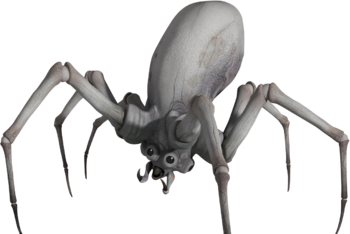
Giant, spider-like creatures native to the planet Atollon that antagonized the Rebellion when it tried to set up a base there. Strongly repulsed by the frequencies emitted by sensor beacons. They can also be found on the ice world of Maldo Kreis.
- Achilles' Heel: Their eyes are the only part of their bodies not covered by thick armor, and consequently their most vulnerable spot.
- All Webbed Up: They trap the Ghost by covering it in their strong webbing. Oddly enough, they avert this with Rex — the one that grabs him simply traps him in its legs.
- Attack Its Weak Point: Krykna bodies are completely invulnerable to blasters, but they go down immediately if you shoot out their vulnerable eyes.
- Brown Note: Sensor beacons emit a frequency that drives the krykna away, something the rebels exploit to keep their base clear of them.
- Giant Spider: They're over twice the height of a human, and have the additional peculiarity of being radially symmetrical.
- Go for the Eye: The only effective way of dealing with krykna (for most) is to shoot out their eyes. Doing that is harder than it sounds, so not many die that way.
- Immune to Bullets: The krykna are immune to blaster fire, even the turbolasers on the Ghost. Their eyes, however, are much softer. They are also vulnerable to lightsabers and grenades.
- Mythology Gag: The krykna are essentially identical to the Knobby White Spiders of the old Legends EU, just without being Planimals like they were.
- No-Sell: For an unspecified reason, the krykna are immune to Ezra's attempts to tame them with the Force. Later episodes show that they are highly sensitive to negative emotion, making them very difficult but not impossible to tame.

Giant wolves native to Lothal. They have a history with the ancient people of Lothal and their ties to the Force.
For tropes specifically referring to Dume, see the Other Force-Users and Beings page.
- Author Appeal: Rebels creator Dave Filoni really likes wolves, so he found a way to integrate them into the story.
- Black Eyes of Evil: Subverted. They have black sclera which makes them look scary, but at worst are simply wild and in some cases are downright benevolent.
- Blue-and-Orange Morality: They have some benevolence but ultimately they are still wolves and strange creatures first and foremost and have their own, alien view of the world and the Force, which can make it difficult to communicate and work with them. Best shown when Ezra is in a depression after Kanan's death: rather than acknowledge his grief, the wolves are outright angry at him for what they see as wasting Kanan's sacrifice. It's not even clear if they recognize grief as an emotion. At one point Zeb says he's glad they're on the rebels' side, at which point Ezra corrects him, saying they're on Lothal's side, and the rebels are only lucky that their goals coincide.
- Canis Major: Adults are at least bigger than an Imperial troop transport. The midseason trailer shows that there's an even bigger variety, who makes the others look like puppies and whose head alone is bigger than an adult human.
- Chekhov's Gunman: Ezra mentions them in a nursery rhyme and they can be seen on the art of the Temple on Lothal as well as in Ahsoka's psychological journey through Malachor. A whole pack finally shows up in season 4 as a key part of the storyline, as they represent the Force on Lothal.
- Color Motif: The ones we see most often are a trio made up of white, grey, and black wolves respectively, representing the different sides of the Force. The white one interacts the most with Kanan and Ezra, possibly because they are also light-aligned. And the giant one Ezra meets has all three colors mixed into its fur.
- Compelling Voice: The white wolf knocks out Sabine by simply telling her to sleep and when she wakes she has no memory of him.
- Creepy Good: Giant wolves with unnaturally deep voices, Sith-like eyes with black sclera, a penchant for Kubrick Stare and other visual tropes usually used for villains, and mind control and glamour powers. Thus far, they've been nothing but benevolent.
- Cruel to Be Kind: Their idea of helping Ezra come to terms with Kanan's death is to chase him, claim it's all his fault, and call him a coward, then when he finally breaks down, talk him through the mourning process. Justified, as these were feelings that Ezra held within himself and that, as more than one Jedi master could attest, tend to lead to the Dark Side.
- Foil: To the Bendu. They're both powerful nature spirits with Blue-and-Orange Morality and normally neutral to sapient affairs forced into war. However the Bendu only does this so he can go back to sleep and attacks both sides not caring who they were as long as they leave, while the loth-wolves are proactively helpful and on the side of the Rebels due to the Empire's devastation of Lothal. The Bendu is a more sapient spirit with an animal side while the lothwolves are animals with an unexpected sapient side, the Bendu seems less serious at first but then proves to be dangerous when pushed while the lothwolves are very frightening but show their wiser side when needed. The best example is when Kanan calls them out for inaction; while the Bendu is truly apathetic to their struggles and only gets involved out of spite, the lothwolves were just stopping Kanan from making a mistake and tell him a better way to save Hera.
- Gaia's Vengeance: Implied. They don't show up in the flesh in Rebels until after Lothal's environment is in bad shape, and loth-wolves and Lothal are hinted to be connected to the Force to some extent. They have an especially strong grudge against Governor Pryce, who was responsible for selling the planet out to the Empire in the first place, and Ezra gets her cooperation by pointing out the lothwolves will eat her unless she helps.
- Godzilla Threshold: They've let the rest of Lothal think they're extinct, using their powers to keep people from seeing them and forget them if they do. With the devastation of Lothal, that's no longer an option.
- Horse of a Different Color: Ezra and friends ride these things as if they were horses.
- Messianic Archetype: The white lothwolf is Force-sensitive, hasn't appeared in a hundred years along with the rest of its species, represents Gaia's Vengeance, has a mysterious grand plan for Lothal against the Empire and thus it may be considered a Big Good, and its Force abilities include tangibility and teleportation depicted as Walk on Water.
- Mix-and-Match Critters: Downplayed. Physically, they're wolves with reptilian scales, reptilian legs, and prehistoric bird feet, but otherwise, they're still identifiable being wolves but bigger.
- Nature Is Not Nice: Unlike the Bendu, the wolves are very upfront about their violent, animalistic side and tend to put other rebels and the Jedi on edge when they're unhappy and snarling at everyone. They don't actually hurt any of the rebels, but that's largely because the rebels have mostly gone along with what they want, and Kanan mouthing off to one almost ends poorly before he backtracks. When Ezra tries to give up, they're openly antagonistic for the first time, chasing and beating him until he gets back into the fight. Then there's what happens during the final episodes of Rebels, with the lothwolves going to town on the hapless imperials. It's 'family friendly' violence, so most of the stormtroopers just get bowled over, knocked senseless, and shaken around, but a couple get the Disney Villain Death treatment of being shown falling off cliffs and are almost certainly dead.
- Nature Spirit: In a way, as they are animals but they are also the expression of Lothal's Force.
 Word of God is that this is based on the wolf's role as a keystone species in real life, as they influence hundreds of other species and the environment itself.
Word of God is that this is based on the wolf's role as a keystone species in real life, as they influence hundreds of other species and the environment itself. - Noble Wolf: Giant, mystical, and occasionally benevolent. The white wolf is gentle with Kanan and helps Sabine and Ezra escape.
- Non-Standard Character Design: Most Star Wars creatures are a "spirit of" rendition of their real-life counterparts. Lothwolves are essentially giant wolves with only a few modifications.
- Not So Extinct: Ezra mentions that no one has seen a lothwolf for a hundred years before he starts seeing them.
- Not So Stoic: In order to get Ezra to trust him, the white lothwolf reveals that it is allies with the white lothcat by having the latter appear on his back. The white lothcat wiggles its ears, and to indicate that this isn't some funny lothcat shenanigans again, the white lothwolf wiggles his ears as well to show that they're friends with each other.
- Sapient Steed: There are cave paintings of them being ridden and Ezra and Sabine ride one in "Flight of the Defender", but Ezra makes sure to get their permission first and they only allow it in emergencies.
- Shout-Out: The leader is white and looks very much like a Star Wars version of the wolves from Princess Mononoke. Their feet resemble the Forest Spirit from the same movie. Numerous scenes involving the lothwolves are homages to Princess Mononoke as well, such as during the teleportation scene, when we are given a camera shot of the white lothwolf's feet as it walks on water reflecting starry space being similar to a camera shot of the Forest Spirit's hooves as it walks against a black background with plant life simultaneously growing and dying in its footsteps.
- Walk on Water: During the teleportation scene in "Kindred", the white lothwolf is seen walking on water, which reflects the starry darkness of space.
- White Wolves Are Special: Lothwolves are normally grey to black, plague farmers, and act more or less exactly like Earth wolves. The white wolf, in contrast, has a spiritual connection to Ezra, can speak, and acts as the Noble Wolf.
The Mythosaur
The mythical ancient apex predators of Mandalore’s past, said to have been ridden by Mandalore the Great and his followers, with its skull having been used as a symbol for Mandalorians ever since. Some, like Bo Katan, doubt those tales… but one still lurks at the bottom of the Living Waters of Mandalore even after the Purge…
- Attack of the 50-Foot Whatever: Its massive skull looks to be significantly larger than a Rancor’s.
- Domesticated Dinosaurs: Or the Kaiju equivalent, with the early Mandalorians said to have ridden them.
- Early-Bird Cameo: As the symbol of the Mandalorian people, it’s skull was first seen on a pauldron of Boba Fett’s armor in the Original Trilogy. The same symbol peridocailly crept up whenever the Fetts or Mandos made appearances elsewhere, but the beast itself didn’t appear until 2023’s The Mandalorian Season 3.
- Living Relic: It’s a direct tie to the ancient tales from Mandalore’s mythical past, even hanging out in the same “lair” the legends claimed it was found in. Bo Katan seems to have a near religious experience upon sighting it.
- Not So Extinct: Either presumed extinct or just extremely rare, even before Mandalore was rendered nigh-uninhabitable by the Empire, but it turns out there's at least one still around.
- Shrouded in Myth: Its lair became a sort of tourist attraction and planetary heirloom since it hadn’t been seen in eons. Bo Katan is shocked to see it there.

The native predators of the savannahs of Maridun.
- Feathered Fiend: Four legged avian predators that will attack and eat anything they come across.
- Mix-and-Match Critters: They're essentially big cats re-skinned as birds.
- Our Gryphons Are Different: They have a vulture-like head and neck, avian legs, the general body shape of a big cat, and no wings.
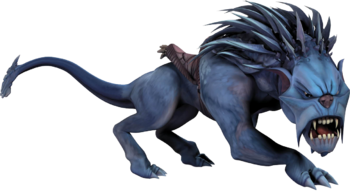
Majestic felines from the frigid world of Orto Plutonia, Narglatches were considered sacred by the local Talz population and were used as mounts and as a source of food by them.
- Canon Immigrant: They first appeared in the now-Legends video game Star Wars Episode I: The Gungan Frontier before appearing in The Clone Wars.
- Fantastic Fauna Counterpart: They're fairly straightforward alien big cats.
- Horse of a Different Color: The Talz tame and ride them in battle.
- Introduced Species Calamity: Escaped Narglatch cubs on Coruscant grew up to be adults and were a very dangerous invasive species for the planet's population.
- Mix-and-Match Critters: The look like big cats with long, fish-like tails and manes made of porcupine-like spines.
- Panthera Awesome: An extraterrestrial example.
- Ridiculously Cute Critter: Their cubs were usually considered very adorable and were kept as pets, but their ferocity increased as they matured, which led to many people getting rid of them.
- Schrödinger's Canon: In Legends they could be found on several planets and were quite adaptable, being able to tolerate the radically different climates of Coruscant, Naboo and Orto Plutonia. Concept art from the Onderon arc also showed a Narglatch that had adapted to living in Onderon's jungles.

A feline predator native to Cholganna.
- Cats Are Mean: And by "mean", we mean "psychotically aggressive". They're not above attacking droids either, despite being of no nutritional value.
- Extra Eyes: Four of them, which can see on the infrared spectrum.
- Glass Cannon: The creature's eventual downfall. It was quite strong, agile, and vicious, and certainly capable of doing a lot of damage, but it lacked bulk. A kick from Padmé sent it flying, and it was killed instantly when rammed by the reek.
- Made of Iron: Being shot twice in the head with a long blaster and stabbed by a genetically augmented super soldier barely hurts the one on Saleucami. It may be the case that they have a fairly weak skeleton and tough hides.
- Mix-and-Match Critters: It has a head that resembles a deep sea fish crossed with a bear trap, the general body shape of a big cat, the tail of a rat, and a few spikes like those of a porcupine.
- More Teeth than the Osmond Family: Its mouth is filled with hundreds of razor-like teeth.
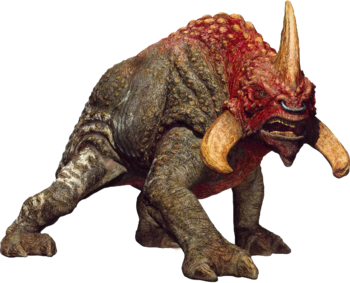
Bovine-esque quadrupeds native to the planet Ylesia, these creatures are normally passive, but can be forcibly enraged when provoked enough.
- Ascended to Carnivorism: By nature, the reek subsists on a vegetarian diet, but when bred for arena killings, they're fed meat. They die on a completely carnivorous diet, so they're given enough plant matter to survive.
- Good Colors, Evil Colors: The reeks used in combat arenas, fed meat to make them more vicious and aggressive, become a deep red color. By contrast, reeks still in their wild, herbivorous state have brown, grey or yellow hides, more in line with what big herbivores naturally look like.
- Horse of a Different Color: Reeks are sometimes used as mounts. General Grievous, for instance, rode one in the Battle of Saleucami.
- Mix-and-Match Critters: Has traits of a rhinoceros and a bull, with a dash of dicynodont
 in there too.
in there too. - Rhino Rampage: One massive horn on head? Check, along with two others on its cheeks. Nasty disposition? Check. Attacks by ramming? Yep, we got a rhino.
- Turns Red: They're not naturally red, but when fed meat, their skin turns that lovely shade.
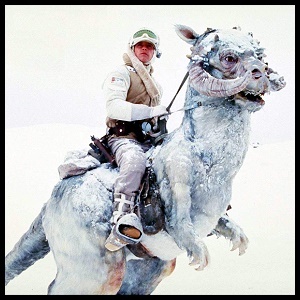
Bipedal, furry reptiles from Hoth, Tauntauns roam the frozen tundra in herds and are a favored prey of the Wampa. The Rebel Alliance domesticated some of these animals and used them as mounts when they established Echo Base on the icy planet.
- Herbivores Are Friendly: They feed on plants and are quite docile.
- Horse of a Different Color: They were used as mounts by the Rebel Alliance on Hoth.
- Mix-and-Match Critters: They have the body stance of a theropod dinosaur with a long tail, a ram-like head with horns and are covered in white fur.
- Non-Mammalian Hair: Beneath their fur, they have scaly skin.
- Prehistoric Animal Analogue: They look mostly mammalian, but have strong dinosaurian influences on their design, such as their bipedal, theropod-like stance.
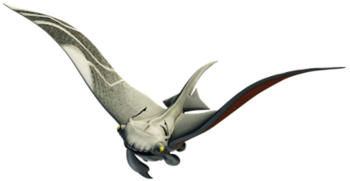
A manta-like flying creature found on Stygeon Prime and Bilzen, among other planets. They are related to neebrays.
- The Cavalry:
- In "Rise of the Old Masters", Hera gets several of them to help her when she goes to pick up the others from the Spire.
- At the beginning of "Shroud of Darkness", Ezra summons one with the Force so he and Kanan can get a lift to escape from the Inquisitors.
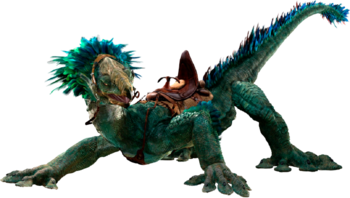
Large reptavians that act as steeds for desert travelers, found on Utapau. One female varactyl, Boga, served as a mount for Obi-Wan Kenobi during the Battle of Utapau at the end of the Clone Wars.
- Amazing Technicolor Wildlife: They're covered in bright, green and blue feathers and scales.
- Horse of a Different Color: Gigantic, quadrupedal feathered lizards used as mounts on an alien world.
- Mama Bear: Towards their riders.
- Mix-and-Match Critters: Like all reptavians, they have traits of both reptiles and birds. In this case, they have bodies like giant lizards and brightly colored feathers.
- Uncertain Doom: Boga was last seen getting knocked into the bottom of the Pau City sinkhole along with Obi-Wan when Order 66 was executed. Obi-Wan survived the fall, but Boga's fate is unclear (she is said to have survived both the shot from the AT-TE's cannon and the fall in Legends).
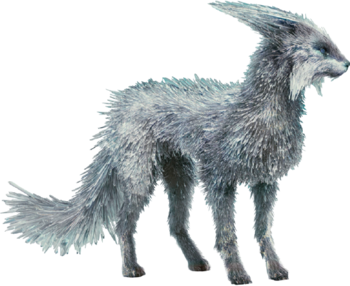
Crystalline foxes native to Crait.
- Fantastic Foxes: These white, crystalline foxes appear benevolent. While they don't actively help anyone, they play a minor but important role in the final act of The Last Jedi, leading the Resistance remnants out of the base.
- Foreboding Fleeing Flock: Inverted. When the vulptices flee the Resistance base on Crait, it's not treated as an omen but as a sign of hope — because they didn't leave through the front door, there must be another exit that the remaining Resistance members can use.
- Gem Tissue: Their fur is made of crystalline bristles.

The primary predator of the planet Hoth, a large, white-furred beast that will attack people if it has the opportunity, but primarily dines on tauntauns.
- An Arm and a Leg: Luke cuts the arm off of the one that captured him.
- Bigfoot, Sasquatch, and Yeti: The wampas' apelike bodies, long white fur and frigid home climate, combined with their horns and solid black eyes, make them look like nothing so much as demonic yetis.
- Horned Humanoid: They are vaguely humanoid, and have two horns on the sides of their head that point towards their mouth.
- Mighty Glacier: Whether in the original film or Shadows of the Empire, they are very strong but move very slowly. They survive by being ambush predators.
- Obscured Special Effects: In the original theatrical version of The Empire Strikes Back, only the wampa's head and arms are seen. The Special Edition added shots of the creature's full body.
- Stealthy Colossus: They are Ursine Aliens that stalk their prey while camouflaged against the snow, then ambush them when the opportunity arises.
- To Serve Man: The one that caught Luke was certainly willing to eat him.
- Ursine Aliens: Polar bears seem to have been the primary influence in their design and possibly their hunting behavior.

A large flying predator native to Iego. They haunt the planet's deep canyons.
- Bat Out of Hell: An extraterrestrial example. Ironically enough, it lives on the same planet as the Angels.
- Extra Eyes: Each Xandu has at least six extra eyes.
- Giant Flyer: They're about two to three times the size of a large human, enabling Anakin and Obi-Wan to use one as a shortcut down to the canyon floor.
- Vertebrate with Extra Limbs: The Xandu not only has big wings, but it also sports a pair of lanky, long arms on its vaguely humanoid body.
Bogano
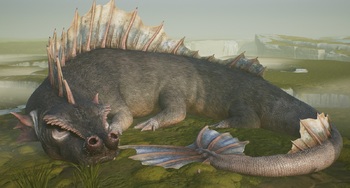
A massive reptilian creature that makes its home on Bogano.
- Gentle Giant: It makes no effort to attack Cal, and is content to playfully roll around in the distance.
- Kaiju: It's absolutely enormous, being almost as large as some of the plataeus in the area.
- Monstrous Scenery: It can be seen sleeping in the background of the Bogano levels; info about the creature can be obtained, but it cannot be interacted with.
- Single Specimen Species: Only one is said to exist at a time due to a very slow breeding cycle.
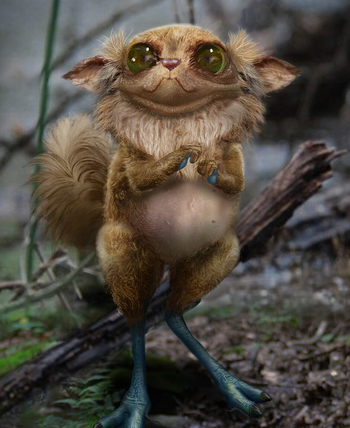
Small burrowing mammals found on Bogano.
- Ridiculously Cute Critter: They're absolutely adorable, with their round fuzzy bodies, big eyes, and method of hopping.
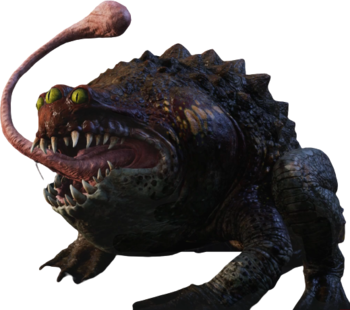
The alpha predators on Bogano, highly resilient and hostile amphibians. A more powerful variant exists; the notorious Oggdo Boggo.
- Amphibian at Large: They're large amphibians around the size of a hippo.
- Extra Eyes: They have three eyes.
- Made of Iron: They can take a ton of punishment before being put down. Most other large enemies can at least have limbs cut off or be impaled with the right pressure, but the only part of an oggdo Cal can cut off is its tongue.
- Mix-and-Match Critters: They have the appearance and prehensile tongue of a frog, and move like one as well, but they have tails, eyes, teeth and armoured scales like a crocodile.
- Tongue Trauma: By using Force Slow, Cal can cut their tongues off if they try shooting it out to grab him.
- Unique Enemy: The Oggdo Boggo is the optional boss fought on Bogano.
- Wake-Up Call Boss: The Oggdo Boggo is likely the first boss many players will encounter, due to how easy it is to fall into its lair, and its high damage and resistance will dispel any illusions of ease any players have with the game.
- You Will Not Evade Me: If Cal gets too out of range for their liking, they can launch their tongues out to grab him.

Large omnivorous arthropods native to Bogano.
- Big Creepy-Crawlies: They look like centipedes with only a couple of segments.
- Zerg Rush: They're only dangerous in large numbers, since unlike most enemies in the game they're not at all impervious to lightsabers. And even then, that's only until Cal gets the double-bladed lightsaber.
Dathomir
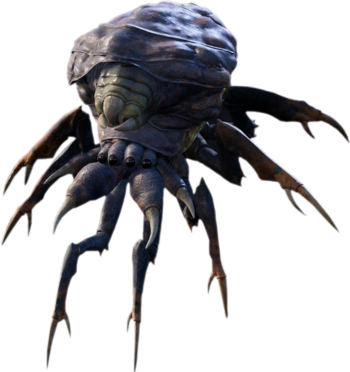
Arachnids native to Dathomir that the local Nightbrothers can bond with, capable of spitting venom.
- Attack Animal: The Nightbrothers use them as this.
- Giant Spider: They're about the size of a dog, though they're less spider-like that the much bigger Wyyyschokks.
- Taking You with Me: They explode into a pool of poison once they are killed.

A giant batlike monster encountered by Cal Kestis on Dathomir, and the apex predator in the region.
- Advancing Boss of Doom: The second phase of Cal's fight against it begins with him frantically clambering up a wall with his new climbing claws as it pursues him.
- The Aloner: Chirodactyls seem to be this by nature. Gorgara seems to be the only Chirodactyl hunting in a wide area around the playable sections of Dathomir and similarly lives alone.
- Attack Its Weak Point: Downplayed Trope, as this isn't the only way to defeat it. Its head is considerably more vulnerable to lightsaber attacks, but generally the only reliable way to attack that is to weaken both its wing joints and then pull it down with the Force to stun it.
- Bat Out of Hell: Gorgara is a massive bat-like creature, powerful enough to both act as an apex predator on Dathomir and be a significant threat to fledgling Jedi Cal Kestis.
- Call a Smeerp a "Rabbit": Both Cal and Merrin refer to the Gorgara as a "bat" at one point. This is because Gorgara's species are also called Dathomirian Bats.
- Giant Flyer: It's enormous; despite having the same proportions as a normal bat, it could still probably swallow Cal whole.
- Made of Iron: Like most enemies in Fallen Order, it is very resistant to a lightsaber.
- Only Known by Their Nickname: Gorgara is in actuality, the only shown member of a species known as Chirodactyls, or Dathomirian Bats. In-universe writing about Dathomir makes it seem like "Gorgara" is the species name but in actuality is talking about the single indivudual Chirodactyl.
- Recurring Boss: Cal fights it twice; first in its cave and he is later attacked while climbing back to the Tomb of Kujet, engaging Gorgara in an aerial battle that ends in the monster's death.
- Shockwave Stomp: It can deliver one of these, a staple of many later-game bosses in the game.

Reptilian predators that threaten the Nightbrothers on Dathomir, including the Lesser Nydaks and the more powerful Nydak Alpha.
- An Arm and a Leg: Parry enough of their attacks in a row and Cal can sever both of their arms.
- Lightning Bruiser: They're extremely fast and hit hard.
- Taking You with Me: Once their health is depleted, they put their dying energy into a last swing to get at their killer.
- Unique Enemy: The Nydak Alpha is the optional boss fought on Dathomir.

Rancors are large, bipedal reptilian carnivores prized by crime lords as trophies and indicators of power. With their long arms, gaping jaws full of sharp teeth and armored hides, they were formidable predators. Not all rancors are hostile. Jungle rancors on Felucia coexist peacefully with the native population.
- Eaten Alive: Some rancors eat their prey without bothering to kill them first.
- Even Evil Has Loved Ones: Malakili, Jabba's Rancor Keeper, is inconsolable when his beloved pet is killed in front of him. You'd think he just lost his only child.
- Fed to the Beast: In the first and most iconic example in Star Wars, the rancor Jabba keeps is used as a means of execution and entertainment in his court.
- Fluffy the Terrible: Both played straight and subverted with Jabba's rancor Pateesa; the Hutt deliberately starved it into a ravenous beast so that it would rip apart anyone he dropped below, and named it "Friend" in Huttese, but the creature developed a genuine emotional rapport with Malakili, the one person in the Palace who treated it with kindness, even saving its keeper's life from a Tusken Raider attack.
- Gentle Giant: The jungle rancor subspecies from Felucia and Teth is rather calm and gets along quite well with the locals. They can become aggressive if attacked however. Even the more infamous Dathomir species is reasonably friendly for large carnivores when not hungry or antagonized and are capable of forming emotional connections with other species.
- Horse of a Different Color: After a trainer tells Boba Fett about the Witches of Dathomir using rancor as their mounts, Boba decides he wants to learn how to ride the juvenile rancor he received from the Hutts.
- Killer Gorilla: Rancors look like giant reptilian gorillas, and in The Book of Boba Fett are shown to have a similar level of agility and intelligence.
- Lightning Bruiser: When able to move and fight in the open, rancors are terrifyingly agile and fast, as well as monstrously strong, and have a hide able to withstand even heavy blaster bolts.
- Meaningful Name: Jabba's rancor is the first of these creatures to be seen, and it oozes rancor.
- Made a Slave: The unfortunate fate of some rancors. Some less savoury individuals like Jabba have been known to enslave the normally peaceful creatures, starving and abusing them to make use of their formidable combative abilities.
- Mix-and-Match Critters: Described as a cross between a bear and a potato by its designers. There are also some gorilla influences as well, and its legs are quite elephantine.
- Named by the Adaptation: Jabba's rancor was nameless in the Legends continuity. In the canonical book Aftermath: Life Debt, the rancor's name is revealed to be Pateesa, the Huttese word for friend.
- Schrödinger's Canon: In Legends, there were many more species of Rancor, such as the Bull Rancor, the Rancor-Dragon and the aquatic Tra'cor. In addition, a group of Force-sensitive humans known as the Witches of Dathomir
 as well as the Nightsistersnote were known to tame rancors and use them as mounts, and considered them an important part of their culture. In fact, rancors could be efficient steeds for those willing to train them. They could also be found on many other worlds aside from Dathomir, Felucia and Teth, such as Lehon (better known as Rakata Prime) and Carida.
as well as the Nightsistersnote were known to tame rancors and use them as mounts, and considered them an important part of their culture. In fact, rancors could be efficient steeds for those willing to train them. They could also be found on many other worlds aside from Dathomir, Felucia and Teth, such as Lehon (better known as Rakata Prime) and Carida. - Tae Kwon Door: Luke kills Jabba's rancor by activating one of the gates in its pit while it is beneath it.
- Too Hungry to Be Polite: Rancors are normally docile and even reasonably friendly unless threatened. They only turn to wanton violence when starved into a state of desperation. They can also be trained as attack animals but aside from that and starvation they are ultimately no more dangerous then any other carnivorous predator.
- Tragic Monster: Jabba's rancor was very mistreated and abused, and left many days (and maybe more) without eating in order to make it more hungry and thus vicious. We could say that its death by the hands of Luke was actually a Mercy Kill for it. In Legends, Luke himself comes to this conclusion after observing wild rancor; saddened he had to kill one because of how vicious the abuse had made it as the poor thing was just as much a victim of Jabba as the people fed to it.
- Top-Heavy Guy: Their upper body is significantly larger than their lower.
Tatooine

A large furry quadruped with long, spiraling horns. Native to Tatooine, but found on other planets as well. Used mainly as mounts, they also produce blue milk.
- Ascended to Carnivorism: While herbivorous by nature, Banthas will situationally consume meat when pressed by hunger, such as the female Bantha who happily accepted the cooked remains of a Womp Rat that Boba Fett fed her.
- Horse of a Different Color: Banthas are commonly used as war mounts and beasts of burden by the Tusken Raiders of Tatooine.
- Mix-and-Match Critters: It resembles a cross between an ox, a ram and wooly mammoth.
- Overly-Long Tongue: They have a long tongue which is prehensile.
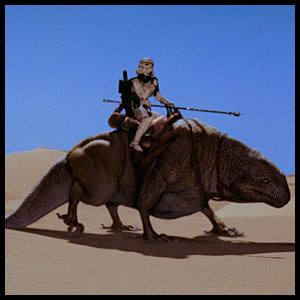
Quadrupedal reptiles that live on Tatooine, Dewbacks could be trained as mounts and were often used by Imperial Sandtroopers. They earn their name because they lick morning dew off their backs.
- Explosive Breeder: Female dewbacks can lay from 50 to 85 eggs every year.
- Horse of a Different Color: They are giant lizards which can be tamed and used as mounts.
- Meaningful Name: Dewbacks lick the morning dew off their own backs, which earned them their name.
- Stock Sound Effects: The Dewbacks in the Special Edition release of A New Hope use the bellows of Parasaurolophus from The Lost World: Jurassic Park.

Eopies are quadruped herbivores native to Tatooine. These tough creatures are well acclimated to their homeworld's endless deserts, and as a result are domesticated by the planet's inhabitants. Due to their value as mounts and beasts of burden, populations of domesticated eopies have become established on several other worlds, such as Saleucami and Zardossa Stix.
- Ascended to Carnivorism: Much like the Bantha, while the it is herbivorous by nature, the scarcity of plant-life on the harsh arid landscapes of Tatooine means beggars cannot be choosers, and therefore the Eopie has also evolved to being a situational carnivore, as shown with Obi-Wan Kenobi's personal Eopie happily munching on the scraps of meat that he feeds her daily.
- Fantastic Fauna Counterpart: For all intents and purposes, they're alien dromedary camels.
- Horse of a Different Color: They are used by Tatooine's inhabitants as mounts or beast of burden.
- Mix-and-Match Critters: The body shape of a dromedary with a tapir-like head.
- Toilet Humour: Jar Jar Binks is unlucky enough to stand right behind an eopie just as it farts right before the Boonta Eve Classic's start.

The apex predators of the planet Tatooine. They come in two subspecies: the smaller and more common Canyon Krayt Dragon and the larger Greater Krayt Dragon. They are known for their prized pearls inside their bodies, though getting them is easier said than done due to their feared reputation for the Tatooine denizens.
- Acid Attack: They can spit out venom that instantly dissolves organic flesh to predigest their prey.
- Always a Bigger Fish: The Greater Krayt Dragon is the undisputed top predator of Tatooine, and even the almighty Sarlacc is just a meal for these creatures.
- The Dreaded: Everyone on Tatooine fears the Greater Krayt Dragon, even the Tusken Raiders. When three of them hear Obi-Wan's imitated roar of a Greater Krayt Dragon, they immediately flee without second thought.
- Feed It a Bomb: How Mando dispatches one in The Mandalorian. Running low on options, he tricks the dragon into devouring a bantha packed with mining explosives and then detonates it, causing the beast to explode from within.
- Hell Is That Noise: The call of a Greater Krayt Dragon is best described as a siren followed by the sound of a runaway train and/or a person screaming in agony. When Tusken Raiders hear such a sound (like Obi-Wan's infamous cry), they start running like hell.
- It Can Think: The one in The Mandalorian shows a surprising amount of intelligence, like going for the bait handler instead of the bait, retreating into its tunnel instead of coming all the way out when the townspeople and Tuskens mount their assault, tunneling to attack from multiple angles, raining acid spit to attack from a distance, and using high ground to increase the effectiveness of its acid spit (and avoid further explosive attacks). It's also familiar with the sound made by starship engines and will burrow to protect itself.
- Nigh-Invulnerable: Blasters, mining explosives and even the Mandalorian's disintegration rifle couldn't leave a mark on it thanks to its thick hide. Its weak spot is soft innards, meaning that it has to be killed from the inside.
- Our Dragons Are Different: In this case, they're multi-legged reptilian titans that swim through desert sands like whales and are the uncontested apex predators of an alien planet. They also produce valuable pearls within their bodies, a trait shared with Greco-Roman dragons.
- Poison Is Corrosive: Krayt dragons can spit "acidic venom", which will dissolve flesh on contact but can also be dried to be used as a regular poison.
- Ribcage Ridge: A Greater Krayt Dragon's skull and spine can be seen when C-3PO wanders through the Dune Sea in A New Hope. It's not even fully grown considering how big the one from The Mandalorian is. When that specimen gets killed, its head and spine falls to ground to be stripped clean of its flesh from the denizens, creating a new skeletal ridge on Tatooine.
- Rite of Passage: For a Tusken Raider to become an official adult, they must hunt a Krayt Dragon and claim its pearl. Evidently, it's the smaller canyon subspecies since The Mandalorian showcases a tribe of Tusken Raiders offering sacrifices to appease the greater variant rather than hunt it down.
- Rent-a-Zilla: The Greater Krayt Dragon is so large that its head and neck alone can wipe out entire armies and can swallow banthas whole.
- Sand Worm: The Greater Krayt Dragon swims through the sand like it is water and ambushes prey from below.
- Swallowed Whole: Although it has a mouth full of jagged teeth, the Greater Krayt Dragon is so large that nearly all of its prey are just swallowed whole alive. It ends up being its undoing when it swallows Mando, who's armed with a jetpack and an array of explosives, without chewing him first.
- Vertebrate with Extra Limbs: Greater Krayt Dragons have ten legs, and the one that terrorized Mos Pelgo has sixteen.
- Wormsign: One of the tell-signs of an imminent Greater Krayt Dragon attack is a very prominent sand disturbance.
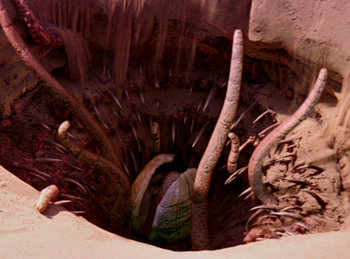
The Sarlacc is a massive, largely immobile creature in the Great Pit of Carkoon on Tatooine, feeding on whatever falls into its pit.
- Adaptational Non Sapience: In Legends, the Sarlacc is semi-sentient and in one story, one of its victim's consciences merged with the Sarlacc's, giving the beast the ability to telepathy talk to its victims as they're slowly digested away. Zigzagged in canon, where the Sarlacc is depicted as just a hungry animal in most stories, and Boba didn't suffer any telepathic Mind Rape during his brief time in the stomach. In its From a Certain Point of View story "My Mouth Never Closes", it's shown that the Sarlacc is actually quite philosophical.
- Adaptational Sympathy: If "My Mouth Never Closes" is any indication, the Sarlacc from the Great Pit of Carkoon is actually a peaceful creature that doesn't prey on living creatures by choice and is rather frustrated that someone keeps force-feeding people to it. Unfortunately, most other sentient beings don't understand it, with the only one who was able to being C-3PO. This is in drastic contrast to the Legends Sarlacc, which was a sadistic monster that psychologically tortured its victims as they were slowly digested alive to pass the time in its sedentary existence.
- Always a Bigger Fish: At least one Sarlacc pit in Tatooine was said to be abandoned because the Sarlacc had been eaten by a Krayt Dragon.
- Ambiguously Related: In "My Mouth Never Closes", the Sarlacc worships the Great Progenitor, which also happens the name of the first Drengir. Between that and having similar anatomical features (such as tentacles, an Eyeless Face and a beaked mouth), this implies that the Sarlacc and Drengir are related species.
- Antlion Monster: A gigantic version — the Sarlacc exhibits a good deal of similarity with the ant
 ◊-lion
◊-lion ◊, an insectoid predator that hides at the base of a shifting sand pit, waiting for other, smaller insects to slide in. However, they are much more mobile and aggressive when they are young.
◊, an insectoid predator that hides at the base of a shifting sand pit, waiting for other, smaller insects to slide in. However, they are much more mobile and aggressive when they are young. - And I Must Scream: According to Legends, Sarlacc's victims spend a solid millennium being digested alive while kept paralyzed in constant agony by a potent neurotoxin. In canon, it seems to be an exaggerated story told by Jabba to terrify his executees, as Boba would have died of suffocation in the belly had he not found a seemingly dead stormtrooper with a still-usable oxygen tank, even if the Sarlacc is capable of preserving the meat for thousands of years.
- Bizarre Alien Reproduction: Sarlacc males live parasitically on the larger females, increasing their own size at the cost of the female's. On reaching the female's original size, the male explodes into a cloud of spores, which travel through space to colonize new worlds.
- Bizarre Sexual Dimorphism: The aggressively predatory Sarlaccs commonly seen are females — males are much smaller and live parasitically off their mates, increasing their own size at the females' expense before exploding in a cloud of spores.
- Combat Tentacles: Sarlaccs have long tentacles that they use to catch its prey.
- Cruel and Unusual Death: Described as the fate of anyone eaten by the Sarlacc. To quote C-3PO:C-3PO: In its belly, you will find a new definition of pain and suffering as you are slowly digested over a... thousand years.
- Death by Adaptation: In Legends, Boba merely left the Great Pit of Carkoon Sarlacc alive after escaping. In Canon, Fennec Shand killed it by having Slave I drop a seismic charge down its throat.
- Extreme Omnivore: It devours anything unfortunate enough to get within range of its tentacles. According to "My Mouth Never Closes", the Carkoon Sarlacc actually prefers plant matter and micro-organisms (which was in abundance back when Tatooine was much more lush) and is irritated by Jabba constantly force-feeding people to it.
- Feed It a Bomb: This is how the sarlacc in the Great Pit of Carkoon meets its end, by eating a seismic charge before it goes off
- Go Mad from the Isolation: Tatooine turning into a barren desert (and Jabba force-feeding people to it) does not do wonders for the Carkoon Sarlacc's sanity.
- Killer Rabbit: While not large enough to swallow people whole and digest them alive yet, baby Sarlaccs are not only mobile, but incredibly vicious.
- Lamprey Mouth: The main mouth is a circular maw with sharp needle-like teeth that point inwards to prevent prey from climbing out. In the beginning of their lifecycle, young Sarlaccs use these maws to rip flesh from prey the size of humans since they cannot swallow them whole.
- Man-Eating Plant: The basic giant Venus Flytrap with tentacles version.
- More Teeth than the Osmond Family: It's presented like a large gaping mouth filled with three rows of sharp teeth.
- My Species Doth Protest Too Much: Unlike most other members of its species, the Carkoon Sarlacc only wished to live in harmony with other living creatures, only feeding on plants and micro-organisms. Unfortunately, Tatooine getting turned into a desert forced it to adjust its metabolism to survive the lack of plants, and Jabba decided to take advantage of its immobility and slow digestive process.
- Nested Mouths: It has two mouths. One is the giant maw of sharp teeth that is visible on the surface of the pit. The second is a retractable beak-like tentacle that lies in the center, waiting to swallow the unfortunate victim and make escape practically impossible.
- Non-Malicious Monster: It only eats the ones unfortunate enough to slip in the pit. In other cases it will leave you alone. That said, Legends portrayed it as being aware of its victims' suffering and enjoying it as a semi-sentient being — while nothing says it does the same in the new canon, nothing says it doesn't either. However, baby Sarlaccs are shown to be pretty aggressive in the Galaxy's Edge comic. In "My Mouth Never Closes", the Carkoon Sarlacc (in contrast to other members of its species) is actually annoyed by Jabba feeding people to it, as it does not actually desire to feast on living beings, and only slowly digests food as an adaptation to Tatooine's now inhospitable environment.
- Not Quite Dead: When Boba Fett and Fennec Shand return to the Pit of Carkoon in the Slave I to retrieve Boba's Mandalorian armor he mistakenly thinks he left inside it, it reveals itself to be still alive and tries to pull the ship down into itself and use its beak to puncture its cockpit to get at Boba and Fennec. A seismic charge down the gullet kills it for real.
- Swallowed Whole: Its prey is dragged into its maw alive and whole. Baby Sarlaccs, however, are too small to swallow most humanoids whole and opt to strip them to the bone.
- Time Abyss: The Great Pit of Carkoon Sarlacc has been alive on Tatooine since before it became a desert (which means if Legends is to be taken into account, it is over 25,000 years old).
Zeffo

Formidable and highly agressive predators native to Zeffo, including a rabid variant.
- An Arm and a Leg: If Cal reduces their health enough, he can use a special attack against them where he servers one of their arms before Impaling It With Extreme Prejudice.
- Lightning Bruiser: The Rabid Jotaz is a lot faster than its normal counterpart.
- Mighty Glacier: They can move across the ground surprisingly quickly, but they're still fairly slow, though powerful.
- Palette Swap: Normal Jotaz have grey-blue stripes, but the Rabid Jotaz is an unhealthy-looking yellow and green.
- Unique Enemy: The Rabid Jotaz, found in the Broken Wing of the wrecked Venator.

Goat-like creatures native to Zeffo.
- Beat Them at Their Own Game: They like kicking people who get behind them. There's an achievement for doing it back.
- Gruesome Goat: Downplayed Trope. They aren't particularly obscene in appareance, but they are extremely hostile to Cal.
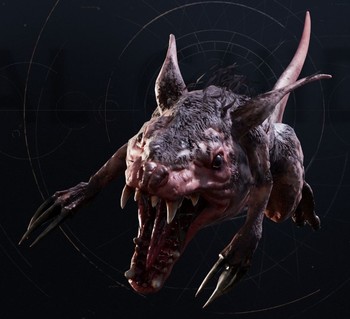
Large rat-like creatures abundantly found on Zeffo.
- Zerg Rush: They like to gang up on their enemies in packs.
Parasitic plant-like organisms that are found underground in the Zeffo tombs.
- Explosive Barrels: A living variant. Once Cal gets Force Push, he can launch them to destroy weakened structures or damage enemies.
Wild Space
Highly venomous multi-legged arthropods from the jungle planet Indoumodo, although they could adapt to any planet. They are frequently weaponized in assassination attempts.
- Attack Animal: What makes them particularly popular with assassins is not only how poisonous they are, but the fact that they are fairly intelligent killer insects that are really stealthy and hard to trace back to their users should they be found.
- Creepy Centipedes: And ones that can not only adapt to any environment, but are really deadly and intelligent killers that use body heat to track prey.
- Poisonous Person: Their poison is so deadly, it can kill most humanoids in minutes.
- Stealth Expert: They are capable of masking their body heat to evade security systems. However, they have no way of evading Force detection.
Unknown Regions

Diminutive coastal-dwelling avians from Ahch-To, males of this species were slightly larger than females. Baby porgs were known as porglets.
- Black Bead Eyes: They have large, round black eyes reminiscent of rodents.
- Breakout Character: They became quite a sensation among the internet before their debut movie was even released thanks to their alien yet still adorable design.
- The Cameo: A carving that depicts a Porg is available for use in Star Wars: Squadrons, though as the game occurs decades before Ahch-To is rediscovered, they go unnamed, with the in-universe explanation being that the Porg carving is the product of an artist stumbling across an ancient manuscript that just-so happened to have a detailed drawing of a porg in it.
- I Just Shot Marvin in the Face: Concept art in The Art of Star Wars: The Last Jedi, shows that originally, the porg investigating Luke's discarded lightsaber was supposed to accidentally activate it and blast through the head of one of his companions.
- Mix-and-Match Critters: Porgs resemble real-life puffins
 with mammalian-like features, particularly in their eyes and their snouts. Their large eyes and white-fur color ending around between the eyes seems seal-like.
with mammalian-like features, particularly in their eyes and their snouts. Their large eyes and white-fur color ending around between the eyes seems seal-like. - Names to Run Away from Really Fast: According to one of the Tales From Wild Space comics, like real life crows, a group of porgs is called a "Murder".
- Puppy-Dog Eyes: Their large eyes seem to have a permanent, pleading expression. They give these to Chewbacca after he's already cooked a few of them up for his dinner.
- Real Life Writes the Plot: Director Rian Johnson has
 stated they were inspired by puffins found on Skellig Michael, the island where the scenes taking place at Ahch-To were filmed. There were so many puffins on the island that chasing them away from the shoot or digitally removing them would have been too time consuming — so they covered them over with flocks of Porgs.
stated they were inspired by puffins found on Skellig Michael, the island where the scenes taking place at Ahch-To were filmed. There were so many puffins on the island that chasing them away from the shoot or digitally removing them would have been too time consuming — so they covered them over with flocks of Porgs. - Ridiculously Cute Critter: Just look at those huge, soulful, pleading eyes!
- Sidekick Creature Nuisance: Chewbacca regards one Porg as one while he's in the midst of flying the Millennium Falcon through a series of tense maneuvers, pushing it off of his dashboard when it starts shrilly chirping one time too many. Even disregarding this individual, a whole flock of porgs seems to have nested in the Falcon during its short time on Ahch-To — Chewie likely let them do out of remorse for killing and eating a few of them.
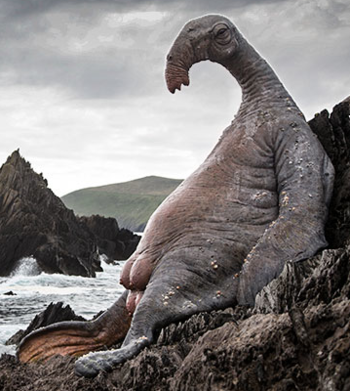
Large flippered pinnipeds that can be found lying on the cliffs of the sacred temple island on Ahch-To. The females' udders produce a green milk, which Luke Skywalker and the Lanai harvest and drink.
- All There in the Manual: The species' name is not mentioned in the film. It appeared in Star Wars: The Last Jedi: The Visual Dictionary.
- Mix-and-Match Critters: Tapir-like heads, desmostylian-like body and udders that can be milked like one would with cows.
- Sirens Are Mermaids: Or rather, sirens look like the inspiration
 for mermaids.
for mermaids.
Unknown
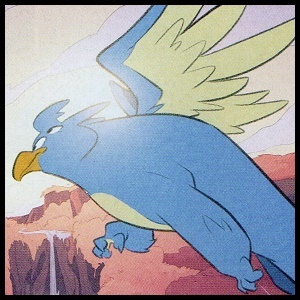
Only a single member of this avian species can live at a time. Its rarity causes it to be worshipped by its planet's natives, although it also puts it at a high risk of being stolen by those who wish to keep it in private zoos.
- Amazing Technicolor Wildlife: It's pure blue.
- Our Griffins Are Different: It resembles a bright blue griffin with four eyes, and with four leonine legs instead of two being mammalian and two avian.
- Single Specimen Species: Only one can be alive at a time, putting it at high risk of extinction.
- Weather Manipulation: It's worshipped for its ability to bring rain to its native world. Most offworlders dismiss this as superstition, but it's revealed to be true by the end.
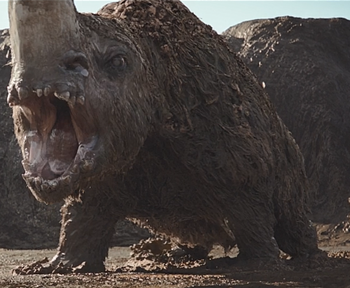
Large horned creatures that inhabit Arvala-7.
- Mama Bear: There's at least one egg in its cave. When Mando comes to steal it for the Jawas the Mudhorn puts up a serious fight to try and stop him. It completely trashes his durasteel armor before he and the Child finally defeat it.
- Meaningful Name: These creatures have a large nasal horn, and they live in muddy valleys of Arvala-7.
- Mix-and-Match Critters: It generally resembles an Elasmotherium, and its face when opening its mouth somewhat resembles a gorilla's (the teeth especially).
- Whale Egg: Despite its mammalian, rhino-like appearance it lays eggs to produce young. The eggs in question have a thick, furry coating similar to that of the adult Mudhorn.
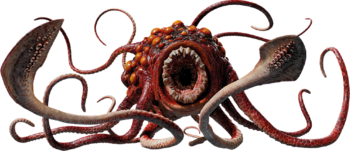
Spherical creatures covered in eyes and tentacles and bearing a circular, jawless mouth, rathtars are extremely dangerous animals and were involved in something known as the Trillia Massacre.
- Bizarre Alien Locomotion: They roll, or drag themselves along by their tentacles.
- Combat Tentacles: Their multiple tentacles are only used to drag prey towards their maws.
- Explosive Breeder: Since they reproduce by fission, their numbers can quickly increase unless something is done to control the population. And given three rathtars are a serious problem... population control for rathtars is much easier said than done. Enough that, as shown during the fall of Starlight Beacon, even Jedi have trouble pacifying them, as cutting them apart with lightsabers would just make things worse (and their presence on Starlight Beacon was just the tip of the iceberg regarding obstacles evacuating the station; other problems included blocked off hangars, radiation leaks, and Nameless loose on the station).
- Extreme Omnivore: They seem to have no problem eating cybernetics, given they chow down on the Guavian Death Gang's henchmen with no more difficulty than they do anything else.
- Giant Squid: They look very much like giant squids IN SPACE, but don't need to live in water.
- It Can Think: Rathtars are noted to get smarter the more of them there are around.
- Lamprey Mouth: They have circular jaws full of razor-sharp teeth.
- Noisy Nature: Rathtars scream, wail and roar as they get near food. They're pack hunters, so the noises are signals to other rathtars.
- Noodle Incident:
- The Trillia Massacre. Nothing is known about it except that these creatures were involved, and it was very bad.
- They were also implied to have eaten most of Han Solo's crew.

A species of lizard-like creatures which appear in sculpture form amid Grand Admiral Thrawn’s art collection.
- Canon Immigrant: They originally appeared in The Thrawn Trilogy before making a cameo in canon as a statue.
- Extra Eyes: They have four eyes.
- Schrödinger's Canon: It’s unknown if they’re a real species in canon, or were only imagined by whoever created the statue of them. If they are a real species, whether they retain their ability to counter Force-users is unconfirmed. Their Legends homeworld, Myrkr, is canonical, but isn't confirmed as their canon homeworld.
Outer Space

Also known as space slugs, exogorths are massive creatures which live in asteroids.
- Bizarre Alien Biology: Silicon-based creatures live in the vacuum of space. They subsist in equal parts on passing ships and creatures and on solar radiation and minerals from their asteroids.
- Bizarre Alien Reproduction: Like the mynocks, these things reproduce by splitting in two like an amoeba.
- Canon Immigrant: Not the species, but their name. The species was first called Exogorth in Knights of the Old Republic (the comic), and later canonized.
- Rent-a-Zilla: They are massive enough to swallow starships whole. They usually top at ten meters or so, but some have been known to reach up to nearly 900 meters.
- Silicon-Based Life: Described as being "more mineral than animal".
- Space "X": Justified in their case, as they live in the vacuum of space itself.
- Swallowed Whole: The fate of the ships, crews and creatures they catch. The largest ones have been known to house ecosystems in their bellies.
- Taken for Granite: They turn to stone when they die. Many asteroid caves are thought to be dead exogorths.
- That's No Moon: While trying to escape the Empire, Han lands the Millennium Falcon inside the stomach of one, mistaking its mouth for a cave on an asteroid.

Large bat-like creatures that can live in the vacuum of space. They frequently attack ships and chew on the power cables.
- Bat Out of Hell: They resemble large bats with Lamprey Mouths.
- Bizarre Alien Biology: Silicon-based lifeforms that eat power cables, live in the void of space, and reproduce by splitting in two.
- Bizarre Alien Reproduction: They reproduce by splitting in half, with each half growing into a new mynock.
- Giant Flyer: While not exactly giant, they're quite large.
- Hell Is That Noise: They can emit a very chilling and ear-piercing screech. It's actually created by playing some horse noises backwards.
- Lamprey Mouth: As seen when one lands on the windshield of the Falcon.
- No Biochemical Barriers: Despite being silicon-based, they can be eaten by carbon-based beings, provided enough seasoning.
- The Symbiote: They're found inside an exogorth and live off the things it eats.

A species of airborne and space-dwelling ray-like creatures of varying size, found on numerous planets and the vacuum of space alike.
- Bizarre Alien Biology: The space dwelling kind has been noted to be gas-eating.
- Extra Eyes: They have three eyes.
- Ridiculously Cute Critter: Some of those who live on planets are the size of large butterflies, likely being babies. They were particularly adorable when they peacefully flocked around Yoda on Rugosa and AP-5 in the middle of lonely outer space.
- Space Whale: Some live in nebulae and grow to gigantic sizes, although they look more like a cross between a manta ray and a deep-sea fish.
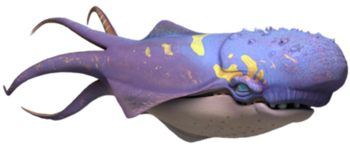
Giant, whale-like, tentacled creatures that live in space, and who served as the inspiration for early starfarers in inventing the hyperdrive. Now, their survival is threatened by collisions with spaceships and companies mining the gases they depend on.
- Androcles' Lion: They might be large and dangerous, but help them and they will pay it back in spades. Ezra rescuing a pod of theirs results in hundreds of them, included several gigantic versions, arriving to destroy the Imperial blockade during the finale battle for Lothal.
- Bioluminescence Is Cool: Their tentacles flash with bioluminescent patterns when they prepare to enter hyperspace, and their eyes glow after they feed.
- Bizarre Alien Biology: They live in deep space, breathe by collecting stores of gas at special asteroids, and can naturally travel through hyperspace.
- Casual Interstellar Travel: Ahsoka demonstrates that the larger ones at least can travel between galaxies, seemingly within a few days.
- Chekhov's Gunman: After their initial appearance in Rebels season 2, hundreds appear with their largest members in tow to save the day in the series finale by disabling the Star Destroyers.
- Combat Tentacles: The larger members use their tentacles to grap and tear apart Star Destroyers.
- Curb-Stomp Battle: The larger members of their species can deal these out to Star Destroyers, punching holes in them by ramming them, and destroying the Imperial blockade in less than a minute.
- Elephant Graveyard: When they're close to death, they travel to Peridea, a planet in another galaxy, and die in orbit. This has been taking place for so long that their bones form a ring around the planet.
- Glowing Eyes: After they feed on enough Clouzon gas to be able to enter hyperspace, their eyes glow a bright light blue.
- Large and in Charge: The Purrgil King is noticeably larger than the rest of his pod.
- Mix-and-Match Critters: Their have a whale-like front half, an octopus-like back half, catfish-like barbels and cuttlefish fins.
- Nature Is Not Nice: The purrgil fall into the "indifferent but still dangerous" category. They also ruthlessly kill (and might have eaten) the foreman who threatened their pod.
- Non-Malicious Monster: The purrgil cause accidents by crashing into ships and nearly rupture the Ghost's hull, but it's not out of malice. They're just big and in the way.
- Protection in Mouth: In the fifth episode of Ahsoka, Ahsoka and Huyang need to follow the Eye of Sion to another galaxy, which New Republic hyperdrives lack the power to do, so Ahsoka force-influences a Purgill from a passing pod to give them a lift, parking her ship inside its mouth to be carried across the void between galaxies.
- Punny Names: Purrgil is a pun on catfish.
- Ramming Always Works: They have naturally thick hides that allow them to ram starships without suffering damage themselves. They're a menace in space lanes for this reason. The bigger ones are tough enough to smash through the hull of a Star Destroyer.
- Shipless Faster-Than-Light Travel:
- They can naturally enter hyperspace and travel faster than light without the need for mechanical aid, provided that they can gather large quantities of a specific gas first to power their organic hyperdrives. It's speculated in "The Call" that ancient spacefarers witnessing purrgil migrations may have been what inspired the invention of hyperspace travel to begin with.
- In Ahsoka, it's revealed that the Nightsisters migrated to the Star Wars galaxy by taming purrgil to carry them across the void.
- Space Whale: They lead nomadic lives in deep space, live in pods, store gas to breathe in a way reminiscent of a whale breaching in reverse, and can naturally achieve FTL spaceflight for massive migrations.
- Stronger with Age: While purrgil do get old and die, as they grow bigger, they get stronger and can seemingly fly through hyperspace even faster. The ones that ferry Ahsoka between galaxies fly through an Imperial minefield and simply jump away after being hit enough, making them tougher than most starships.

A gigantic cephalopod living in the gas nebulas of the Akkadese Maelstrom near the Maw, the unstable and mostly unnavigable cluster of black holes located near Kessel. An altered subspecies of the Summa-verminoth lived in the Red Horror nebula near Exogol.
- All There in the Manual: Its name comes from Solo: A Star Wars Story — The Official Guide.
- Always a Bigger Fish: The only way to get rid of one? Luring it into a black hole.
- Bizarre Alien Biology: It resembles a blend of octopus and jellyfish, but for some reason has a skeleton, which neither octopodes nor jellyfish have.
- Combat Tentacles: It has a large number of tentacles, and uses them to try to grab the Millennium Falcon.
- Cyclops: While most Summa-verminoth have multiple eyes, the Red Nebula subspecies only has one.
- Eldritch Abomination: A gigantic abomination living in gas nebulas near a cluster of black holes. The Red Horror Summa-verminoth are also capable of Mind Raping their prey.
- Electric Jellyfish: Its tentacles crackle with bio-electricity. It's so massive that its grasping at the Falcon almost resembles a lightning storm.
- Expy: As a tentacled near-Eldritch Abomination hiding in the Maw, it seems to be inspired by the Legends character Abeloth. However, other than that description and their shared ability to Mind Rape victims such as Sith Lords, that is where the similarities end.
- Extra Eyes: It has a lot of eyes — at least a dozen or so — scattered around the front of its head.
- Flaying Alive: The one that gives chase in Solo falls to this fate. After getting lured into a black hole, the creature manages to resist its gravitational pull to avoid dying instantly, but that doesn't stop the sheer force of gravity from gradually tearing off all of its tentacles, skin and eyes off until it's just a lifeless skeleton getting pulverized.
- Giant Squid: Emphasis on giant — it's significantly bigger than most spaceships, and easily the biggest creature in the Star Wars canon. However, its general design is actually closer to a jellyfish than it is to a squid.
- Kraken and Leviathan: For all intents and purposes, the Summa-verminoth is a space-dwelling kraken. It has all the characteristics of the classic deep-sea terror — it's a colossal tentacled monster that will eagerly devour human-made vessels and greatly dwarfs the ships it preys on — but in space rather than in the sea. In Star Wars, Space Is an Ocean anyway.
- Mind Rape: The Red Horror subspecies have some psychic abilities, which includes feeding unpleasant visions into people's minds or making them relive terrible memories.
- More Teeth than the Osmond Family: It has a large jaw with plenty of teeth.
- Oh, Crap!: The creature in Solo gets a very visible reaction in its eyes when it realizes that it's now stuck in the pull of a black hole.
- Out of the Frying Pan: The Millennium Falcon's crew successfully gets rid of a squadron of TIE fighters... only to bump into this creature.
- Rent-a-Zilla: This is probably the biggest creature ever seen in the Star Wars universe.
Peridea Galaxy
- All Animals Are Dogs: They display typical canine behaviors when domesticated, such as whimpering when scolded and panting happily.
- Author Appeal: Dave Filoni has said many times that his favorite animal is the wolf. And the Howler first turned up in a show that he's spearheading.
- Canis Major: Much larger than any real-world canine, though not quite as big as the Lothwolves.
- Horse of a Different Color: The primary domesticated mount on Peridea.
- Mix-and-Match Critters: They have crocodile-like snouts.

